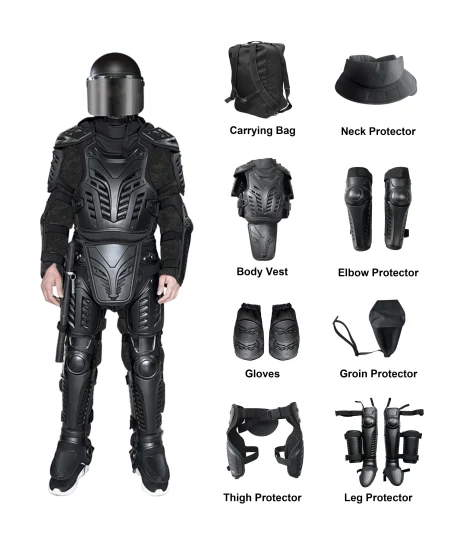Riot suits play a crucial role in ensuring the safety of law enforcement officers during protests and civil unrest. These specialized suits are designed to offer maximum protection against various potential dangers and to allow officers to effectively control volatile situations. In this article, we will explore the key components and features of riot suits and discuss how they protect police officers while maintaining law and order.
Anti Riot Suit for Police and Army
Civil unrest and protests can quickly escalate into violent situations, posing significant risks to both officers and the public. Riot suits, also known as tactical suits or protective ensembles, are specifically engineered to safeguard law enforcement personnel. These suits provide a wide range of protections, including resistance to physical assault, chemical irritants, and projectiles.
Components of a Riot Suit
A riot suit typically consists of several components designed to protect specific areas of the body. These may include:
1. Helmet
The helmet is an essential part of a riot suit, providing protection for the head and face. It is usually made of durable materials such as polycarbonate, which is impact-resistant. The helmet often features a clear visor to protect the face from projectiles, chemical sprays, and other potential hazards.
2. Body Armor
The body armor forms the core of a riot suit, offering protection to the chest, back, and sides of the torso. It is typically made of high-strength synthetic materials like Kevlar or ballistic nylon. These materials are capable of withstanding stabbing, slashing, and impact from blunt objects. Riot suits may also include additional panels to protect the shoulders and groin area.
3. Limb Protection
Riot suits feature arm and leg protectors that shield the extremities from potential injuries. These protectors are designed to be flexible, allowing officers to move freely while maintaining a high level of protection. Specialized padding may be incorporated to absorb impact from batons or projectiles.
Features of Riot Suits
Apart from the essential components, riot suits often incorporate additional features to enhance their efficacy in controlling civil unrest. Some notable features include:
1. Flame Resistance
Riot suits are often treated with flame-resistant materials or coatings, ensuring that officers are protected in situations involving molotov cocktails or arson attempts. This feature minimizes the risk of severe burns and allows officers to operate in hazardous environments safely.
2. Chemical Protection
Chemical irritants are frequently deployed during protests, posing a significant threat to officers. Riot suits often feature chemical-resistant layers, which provide a barrier against these substances. This protection enables officers to maintain security and control even in the presence of tear gas or pepper spray.
3. Mobility and Comfort
To effectively control civil unrest, officers must be able to move swiftly and react quickly. Riot suits are designed to balance protection and mobility, allowing officers to perform their duties unhindered. Lightweight and adjustable components ensure a comfortable fit and ease of movement.
The Importance of Riot Suits
Riot suits significantly contribute to the safety and effectiveness of law enforcement officers during civil unrest. Police officers equipped with these protective ensembles are better prepared to handle volatile situations, ensuring a higher level of public safety.
1. Protection and Confidence
Riot suits instill a sense of confidence in officers, knowing they have comprehensive protection against potential threats. This confidence allows them to focus on maintaining order without constantly worrying about personal safety.
2. Deterrence and Control
The presence of officers in riot suits acts as a deterrent to potential troublemakers, discouraging them from engaging in violent or unlawful behavior. Riot suits project authority and demonstrate a commitment to ensuring public safety. Additionally, the enhanced protection provided by these suits enables officers to effectively control and subdue aggressive individuals or groups.
Riot suits are indispensable tools for law enforcement agencies dealing with civil unrest and protests. These specialized ensembles offer comprehensive protection to officers, safeguarding them from physical assaults, projectiles, and chemical irritants. By wearing riot suits, officers are better prepared to handle volatile situations and maintain law and order effectively. The investments made in developing and equipping officers with high-quality riot suits ultimately contribute to public safety and the overall well-being of communities.


